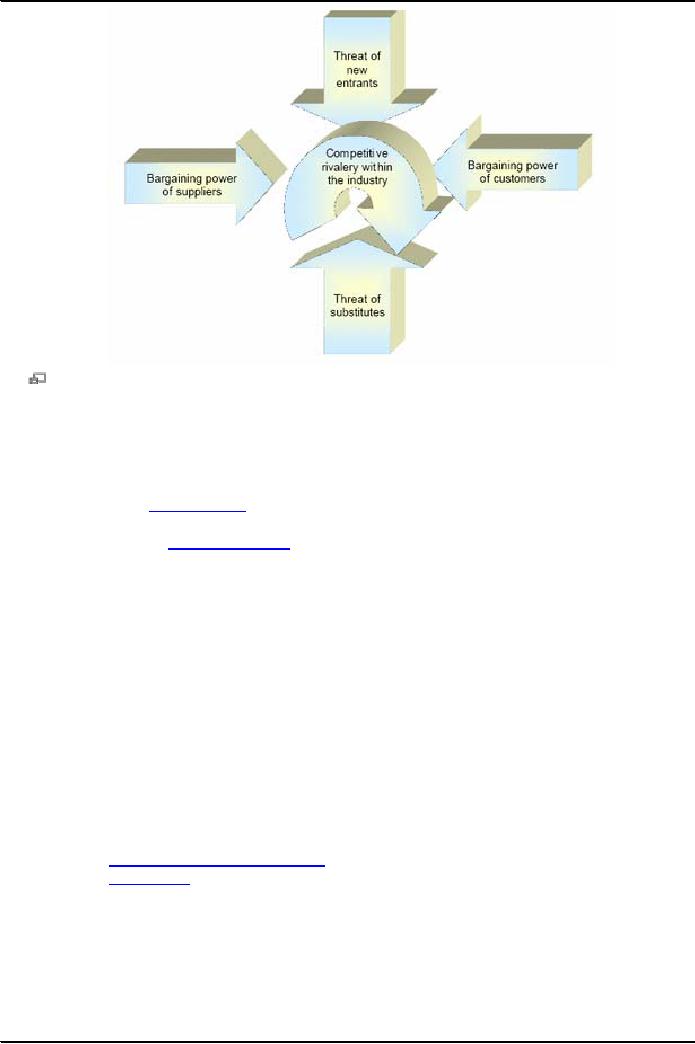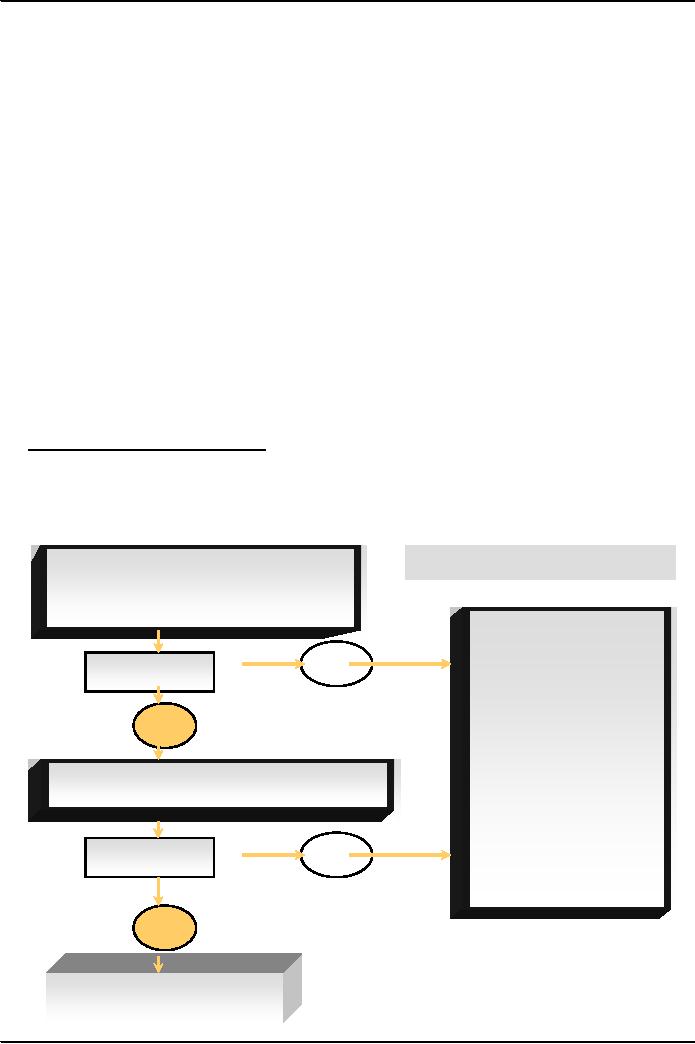 |
STRATEGY REVIEW, EVALUATION AND CONTROL:Evaluation, The threat of new entrants |
| << RESEARCH AND DEVELOPMENT ISSUES |
| PORTER SUPPLY CHAIN MODEL:The activities of the Value Chain, Support activities >> |

Strategic
Management MGT603
VU
Lesson
40
STRATEGY
REVIEW, EVALUATION AND CONTROL
Learning
objectives
The
last step of strategy frame
work model is control evaluation. In this
chapter the main concern
is
evaluation
process its importance and
porter five forces
model
Evaluation
Evaluation
is the systematic determination of merit,
worth, and significance of
something or someone.
Evaluation
often is used to characterize
and appraise subjects of
interest in a wide range of
human
enterprises,
including the
Arts,
business,
computer
science,
criminal
justice,
education,
engineering,
foundations
and
non-profit
organizations,
government,
health
care,
and other human
services.
In
the field of evaluation, there is some
degree of disagreement in the distinctions
often made between
the
terms 'evaluation' and 'assessment.'
Some practitioners would consider
these terms to be
interchangeable,
while others contend that evaluation is
broader than assessment and involves
making
judgments
about the merit or worth of something
(an evaluand) or someone (an
evaluee). When such a
distinction
is made, 'assessment' is said to
primarily involve characterizations
objective descriptions,
while
'evaluation' is said to involve
characterizations and
appraisals
determinations of merit
and/or
worth.
Merit involves judgments
about generalized value.
Worth involves judgments
about instrumental
value.
For example, a history and a
mathematics teacher may have
equal merit in terms of
mastery of
their
respective disciplines, but the
math teacher may have
greater worth because of the higher
demand
and
lower supply of qualified mathematics
teachers. A further degree of
complexity is introduced to this
argument
when working in different languages,
where the terms 'evaluation' and
'assessment' may be
variously
translated, with terms being
used that convey differing
connotations related to conducting
characterizations
and appraisals.
There
are many methods, techniques
and approaches for conducting
evaluations. The following
list
includes
some of the most
common.
142

Strategic
Management MGT603
VU
�
Accelerated
aging
�
�
�
Cost-benefit
Interview
Quantitative
�
Action
research
�
analysis
research
Marketing
�
�
�
Advanced
Data
mining
Questionnaire
research
�
�
�
Product
Quality
Delphi
Technique
Meta-analysis
Questionnaire
�
�
Planning
construction
Discourse
analysis
Metrics
�
Alternative
�
�
�
Root
cause
Electronic
Multivariate
assessment
analysis
portfolio
statistics
�
Appreciative
�
�
�
Rubrics
Environmental
Naturalistic
�
Inquiry
scanning
observation
Sampling
�
Assessment
�
�
�
Ethnography
Observational
School
�
Axiomatic
design
�
techniques
accreditation
Experiment
�
Benchmarking
�
�
�
Opinion
polling
Self-assessment
Experimental
�
Case
study
�
�
Organizational
Six
Sigma
techniques
�
Change
�
�
learning
Factor
analysis
Standardized
�
�
management
Participant
testing
Factorial
�
Clinical
trial
�
observation
Statistical
process
experiment
�
�
Cohort
study
�
Policy
analysis
control
Feasibility
study
�
�
�
Competitor
�
Process
Statistical
survey
Field
experiment
�
improvement
�
Statistics
analysis
Fixtureless
In-
�
�
Consensus
�
Project
Strategic
planning
Circuit
Test
management
�
�
decision-making
Focus
group
Structured
�
�
Consensus-
Qualitative
�
interviewing
Force
field
research
�
seeking
decision-
analysis
Systems
theory
�
making
Quality
audit
�
�
Game
theory
Student
testing
�
Content
analysis
�
Quality
circle
�
�
Grading
Total
Quality
�
Conversation
�
Quality
control
�
Management
Inquiry
�
analysis
�
Quality
Triangulation
management
�
Quality
Management
System
Strategy
Evaluation
Organizations
are most vulnerable when
they are at the peak of
their success.
R.T.
Lenz
"Strategy
evaluation alerts management to potential
or actual problems in a timely
fashion."
It is Complex
and sensitive undertaking
Overemphasis
can be costly and
counterproductive
Systematic
Review, Evaluation &
Control
1.
Strategies become
obsolete
2.
Internal environments are
dynamic
3.
External environments are
dynamic
Michael
Porter's
five forces
Michael
Porter's
1979
framework
uses concepts developed in Industrial
Organization (IO) economics
to
derive 5 forces that determine the
attractiveness of a market. Porter referred to
these forces as the
microenvironment,
to contrast it with the more
general term macro
environment.
They consist of those
forces
close to a company that affect
its ability to serve its
customers and make a profit.
A change in
any
of the forces normally requires a
company to re-assess the
marketplace.
Five
Forces
Five
forces -- the bargaining power of customers, the
bargaining power of suppliers, the threat of
new
entrants,
and the threat of substitute products -- combine
with other variables to influence a
fifth force,
the
level of competition in an industry. Each
of these forces has several
determinants:
143

Strategic
Management MGT603
VU
A
graphical representation of Porters
Five Forces
�
The
bargaining power of
customers
o
buyer
concentration to firm concentration ratio
o
bargaining
leverage
o
buyer
volume
o
buyer
switching
costs relative
to firm switching costs
o
buyer
information availability
o
ability
to backward
integrate
o
availability
of existing substitute products
o
buyer
price sensitivity
o
price
of total purchase
�
The
bargaining power of
suppliers
o
supplier
switching costs relative to firm switching
costs
o
degree
of differentiation of inputs
o
presence
of substitute inputs
o
supplier
concentration to firm concentration ratio
o
threat
of forward integration by suppliers
relative to the threat of backward integration
by
firms
o
cost
of inputs relative to selling price of the
product
o
importance
of volume to supplier
�
The
threat of new
entrants
o
the
existence of barriers to
entry
o
economies
of product differences
o
brand
equity
o
switching
costs
o
capital
requirements
o
access
to distribution
o
absolute
cost advantages
o
learning
curve advantages
o
expected
retaliation
o
government
policies
144

Strategic
Management MGT603
VU
�
The
threat of substitute
products
o
buyer
propensity to substitute
o
relative
price performance of
substitutes
o
buyer
switching costs
o
perceived
level of product differentiation
�
The
intensity of competitive rivalry
o
power
of buyers
o
power
of suppliers
o
threat
of new entrants
o
threat
of substitute products
o
number
of competitors
o
rate
of industry growth
o
intermittent
industry overcapacity
o
exit
barriers
o
diversity
of competitors
o
informational
complexity and asymmetry
o
brand
equity
o
fixed
cost allocation per value
added
o
level
of advertising expense
Some
argue that a 6th force should be
added to Porter's list to include a
variety of stakeholder groups
from
the task environment. This force is referred to as
"Relative Power of Other Stakeholders".
Some
examples
of these stakeholders are
governments, local communities,
creditors, and
shareholders.
This
5 forces analysis is just
one part of the complete Porter
strategic models. The other
elements are
the
value
chain and
the generic
strategies.
Purpose
of strategy evaluation
�
Strategy
evaluation is vital to the organization's
well-being
�
Alert
management to potential or actual
problems in a timely fashion
�
Erroneous
strategic decisions can have
severe negative impact on
organizations
Basic
Activities
1.
Examining the underlying bases of a
firms' strategy
2.
Comparing expected to actual
results
3.
Corrective actions to ensure performance
conforms to plans
In
many organizations, evaluation is an
appraisal of performance
�
Have
assets increased?
�
Increase
in profitability?
�
Increase
in sales?
�
Increase
in productivity?
�
Profit
margins, ROI and EPS
ratios increased
Four
Criteria (Richard Rummelt):
�
Consistency
�
Consonance
�
Feasibility
�
Advantage
Consistency
Strategy
should not present inconsistent
goals and policies.
�
Conflict
and interdepartmental bickering symptomatic of
managerial disorder and
strategic
inconsistency
145

Strategic
Management MGT603
VU
Consonance
Need
for strategies to examine
sets of trends
�
Adaptive
response to external environment
�
Trends
are results of interactions among
other trends
Feasibility
Neither
overtax resources nor creates unsolvable
sub problems
�
Organizations
must demonstrate the abilities,
competencies, skills and
talents to
carry
out a given strategy
Advantage
Creation
or maintenance of competitive
advantage
�
Superiority
in resources, skills, or
position
The
process of evaluating
Strategies
1.
Strategy evaluation is necessary for
all sizes and kinds of organization.
Strategy evaluation should
initiate
managerial questioning of expectations
and assumptions should trigger a review of
objectives
and
values and should stimulate creativity in
generating alternative and formulating
criteria of
evaluation
2.
Evaluating strategies on continuous rather
than a periodic basis allows
benchmark of progress to
established
and o\more effectively
monitored
3.
Managers and employees of the
firm should be continually aware of
progress being made
towards
achieving
the firm's objectives. As a critical
success factors change, organization
members should be
involved
in determining appropriate corrective action.
A
Strategy-Evaluation Framework
Strategy-evaluation
activities in terms of key questions
that should be addressed, alternative
answers to
those
questions, and appropriate actions
for an organization to take. Notice
that corrective actions
are
almost
always needed except when
(1) external and internal
factors have not significantly
changed and
(2)
The firm is progressing
satisfactorily toward achieving
stated objectives.
Evaluation
Framework
I.
Review Underlying
Bases
III.
Take
Yes
Differences?
Corrective
Actions
NO
II.
Measure Firm Performance
Yes
Differences?
NO
Continue
present course
146
Table of Contents:
- NATURE OF STRATEGIC MANAGEMENT:Interpretation, Strategy evaluation
- KEY TERMS IN STRATEGIC MANAGEMENT:Adapting to change, Mission Statements
- INTERNAL FACTORS & LONG TERM GOALS:Strategies, Annual Objectives
- BENEFITS OF STRATEGIC MANAGEMENT:Non- financial Benefits, Nature of global competition
- COMPREHENSIVE STRATEGIC MODEL:Mission statement, Narrow Mission:
- CHARACTERISTICS OF A MISSION STATEMENT:A Declaration of Attitude
- EXTERNAL ASSESSMENT:The Nature of an External Audit, Economic Forces
- KEY EXTERNAL FACTORS:Economic Forces, Trends for the 2000’s USA
- EXTERNAL ASSESSMENT (KEY EXTERNAL FACTORS):Political, Governmental, and Legal Forces
- TECHNOLOGICAL FORCES:Technology-based issues
- INDUSTRY ANALYSIS:Global challenge, The Competitive Profile Matrix (CPM)
- IFE MATRIX:The Internal Factor Evaluation (IFE) Matrix, Internal Audit
- FUNCTIONS OF MANAGEMENT:Planning, Organizing, Motivating, Staffing
- FUNCTIONS OF MANAGEMENT:Customer Analysis, Product and Service Planning, Pricing
- INTERNAL ASSESSMENT (FINANCE/ACCOUNTING):Basic Types of Financial Ratios
- ANALYTICAL TOOLS:Research and Development, The functional support role
- THE INTERNAL FACTOR EVALUATION (IFE) MATRIX:Explanation
- TYPES OF STRATEGIES:The Nature of Long-Term Objectives, Integration Strategies
- TYPES OF STRATEGIES:Horizontal Integration, Michael Porter’s Generic Strategies
- TYPES OF STRATEGIES:Intensive Strategies, Market Development, Product Development
- TYPES OF STRATEGIES:Diversification Strategies, Conglomerate Diversification
- TYPES OF STRATEGIES:Guidelines for Divestiture, Guidelines for Liquidation
- STRATEGY-FORMULATION FRAMEWORK:A Comprehensive Strategy-Formulation Framework
- THREATS-OPPORTUNITIES-WEAKNESSES-STRENGTHS (TOWS) MATRIX:WT Strategies
- THE STRATEGIC POSITION AND ACTION EVALUATION (SPACE) MATRIX
- THE STRATEGIC POSITION AND ACTION EVALUATION (SPACE) MATRIX
- BOSTON CONSULTING GROUP (BCG) MATRIX:Cash cows, Question marks
- BOSTON CONSULTING GROUP (BCG) MATRIX:Steps for the development of IE matrix
- GRAND STRATEGY MATRIX:RAPID MARKET GROWTH, SLOW MARKET GROWTH
- GRAND STRATEGY MATRIX:Preparation of matrix, Key External Factors
- THE NATURE OF STRATEGY IMPLEMENTATION:Management Perspectives, The SMART criteria
- RESOURCE ALLOCATION
- ORGANIZATIONAL STRUCTURE:Divisional Structure, The Matrix Structure
- RESTRUCTURING:Characteristics, Results, Reengineering
- PRODUCTION/OPERATIONS CONCERNS WHEN IMPLEMENTING STRATEGIES:Philosophy
- MARKET SEGMENTATION:Demographic Segmentation, Behavioralistic Segmentation
- MARKET SEGMENTATION:Product Decisions, Distribution (Place) Decisions, Product Positioning
- FINANCE/ACCOUNTING ISSUES:DEBIT, USES OF PRO FORMA STATEMENTS
- RESEARCH AND DEVELOPMENT ISSUES
- STRATEGY REVIEW, EVALUATION AND CONTROL:Evaluation, The threat of new entrants
- PORTER SUPPLY CHAIN MODEL:The activities of the Value Chain, Support activities
- STRATEGY EVALUATION:Consistency, The process of evaluating Strategies
- REVIEWING BASES OF STRATEGY:Measuring Organizational Performance
- MEASURING ORGANIZATIONAL PERFORMANCE
- CHARACTERISTICS OF AN EFFECTIVE EVALUATION SYSTEM:Contingency Planning